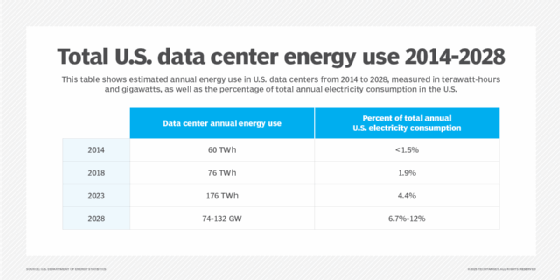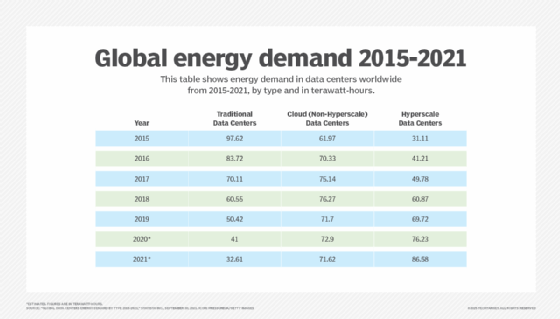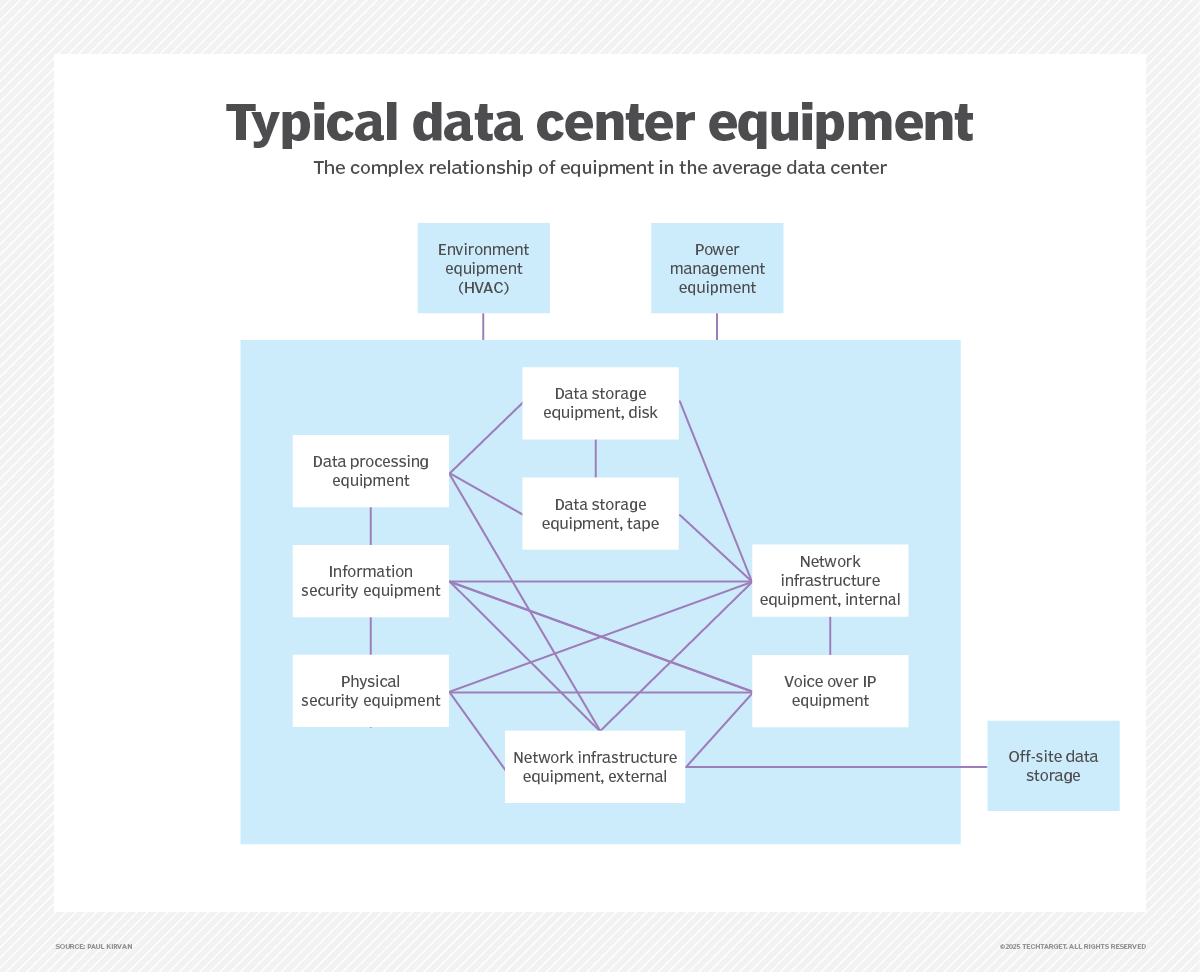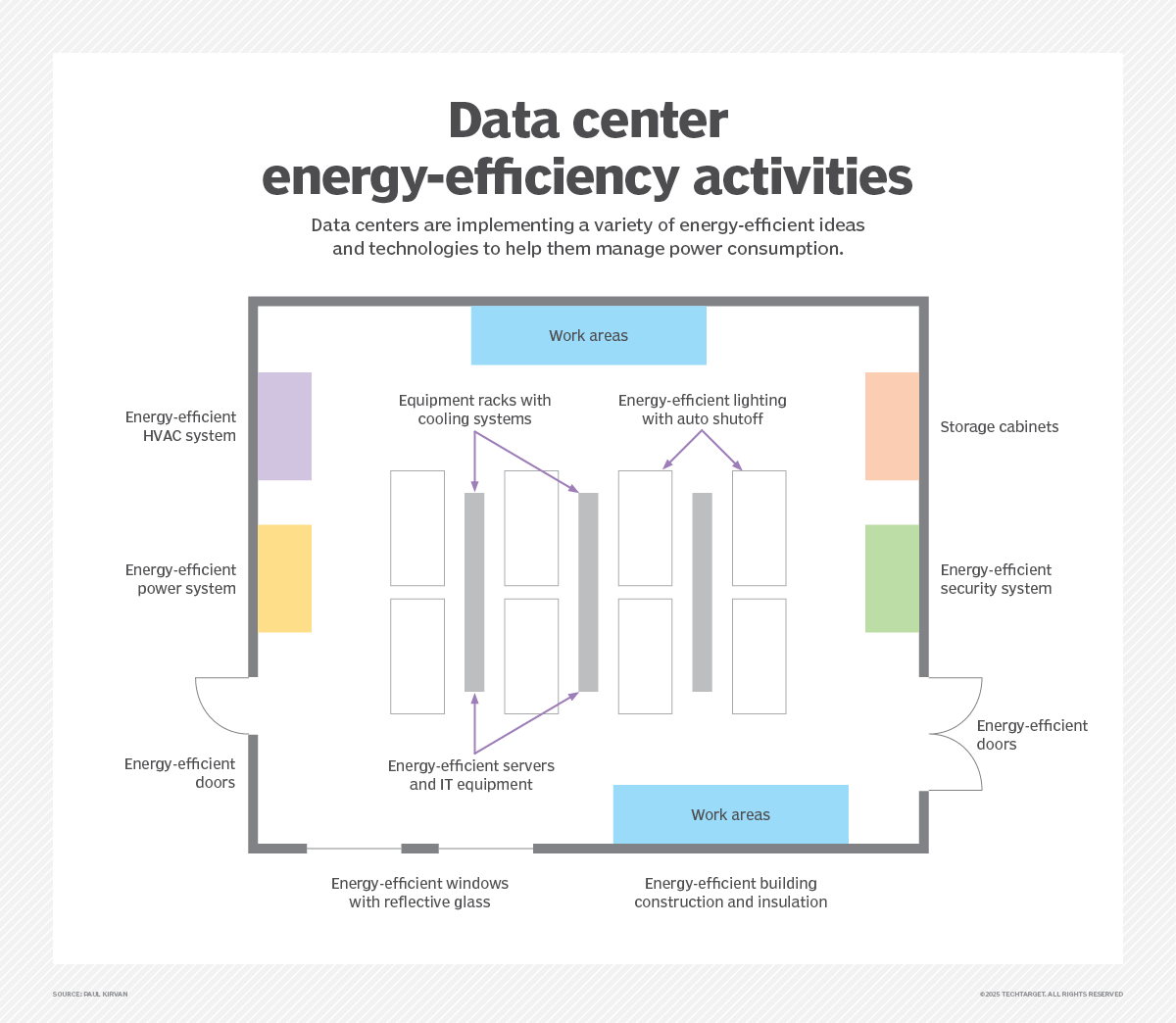How much energy do data centers consume?
High energy consumption continues to be an issue for data centers with the rise in AI use, but organizations are moving to energy-efficient systems to manage their power usage.
Data centers are among the highest consumers of electric power. Studies have shown that data center energy consumption increases annually, with three identifiable trends.
The first trend is that mainstream legacy corporate data centers continue to be major consumers of power, despite many organizations migrating systems and hardware to cloud environments. However, while average use is increasing steadily, it's doing so at a lower rate than 25 years ago, when cloud data centers emerged as a major alternative to legacy facilities.
The second trend is that while large cloud data centers, often called hyperscale data centers, are steadily increasing their power usage, they balance that consumption by investing in green initiatives, such as energy-efficient equipment. They're also revamping supporting systems, such as HVAC, security and lighting equipment.
That said, the proliferation of energy-intensive AI applications is a new trend that will have major implications for future data center energy consumption.
Estimates on global data center energy usage
The following paragraphs provide estimates and forecasts of data center energy consumption in the U.S. The data reinforces the importance of using energy-efficient equipment in data centers.
The DOE's "2024 United States Data Center Energy Usage Report" was produced by Lawrence Berkeley National Laboratory's Center of Expertise for Energy Efficiency in Data Centers and funded through the DOE's Industrial Efficiency and Decarbonization Office. The report outlines the energy use of data centers from 2014 to 2028.
According to the report, from 2014 to 2016, the annual energy consumption of data centers in the U.S. remained stable at approximately 60 TWh. By 2018, this figure had increased to around 76 TWh, accounting for 1.9% of the country's total electricity consumption. As of 2023, energy use by U.S. data centers reached 176 TWh, representing 4.4% of overall electricity consumption in the U.S.
The current total data center energy demand has more than doubled between 2017 and 2023, according to the Berkeley's Lab report. This is primarily due to the use of accelerated servers for AI services. The report also predicts future scenarios that estimate a total power demand for data centers to be between 74 and 132 GW (gigawatts) in 2028. This power demand for data centers would equate to about 6.7% to 12.0% of total U.S. electricity consumption for 2028.

Based on historical data, the electricity consumption of U.S. data centers is growing at an accelerating compound annual growth rate (CAGR) of about 7% from 2014 to 2018 and 18% from 2018 to 2023. The report predicts this growth rate to increase further -- ranging from 13% to 27% between 2023 and 2028 -- based on an analysis of new trends and the most recent available data.
The integration of new efficiency strategies is necessary to reduce the negative impacts of the current and future energy surges coming from the data center industry.
A closer look at data center types and energy use
Another analysis of data center energy consumption patterns was published by Statista Inc. on Sept. 30, 2021. The report, "Global Data Centers Energy Demand by Type 2015 -- 2021," by Nane Sönnichsen, found that traditional data centers have significantly reduced their energy demand, decreasing from approximately 97.6 TWh in 2015 to about 50 TWh in 2019. Forecasts suggest that electricity demand will decline to 33 TWh by 2021. Hyperscale data centers, however, have seen their energy demand double during this period.
The report also provided a year-by-year forecast of data center usage in three categories: traditional data centers, non-hyperscale cloud data centers and hyperscale data centers.

Traditional data center operators are typically concerned with maximizing output and performance, often ignoring the power implications. For large organizations, the need for increased computing power often resulted in building additional data centers, significantly increasing energy consumption. The earlier years shown in the table above reflect this trend.
However, the availability of significant computing resources without the need for floor space fueled the trend of shutting down legacy data centers and moving operations to the cloud.
Non-hyperscale cloud data centers demonstrate their use of energy-efficient equipment and environmental systems by keeping their energy consumption steady. Hyperscale cloud data centers have steadily increased their energy usage and effectively managed it for similar reasons.
Hyperscale data centers have aggressively invested in sustainability strategies for two primary reasons. According to Uptime Institute's research, larger facilities are more efficient and more likely to yield an ROI from energy savings. This is partly due to newer hyperscale data centers using leading-edge equipment that provides more efficient cooling designs and optimizing controls.
There's also something to be said for operating at larger scales -- large data centers are more likely to have blind spots and less granular control over their equipment since there are so many machines at work. When automated tools are applied across the board, the gains are greater than smaller data centers that might already have deeper insight and control over operations.
Another reason for this investment in green technologies is the growing customer demand that's spotlighting hyperscalers' energy consumption, pressuring them to find eco-conscious resources. This pressure has led to positive change. According to Data Centre Magazine, for example, AWS has set ambitious sustainability goals, including reaching net-zero emissions by 2040 and using 100% renewable energy by 2025 -- five years ahead of their original target of 2030. This infrastructure is also five times more energy efficient than average-sized European data centers and 3.6 times more efficient, on average, than those in the U.S.
AWS is just one example of how hyperscalers are incorporating green initiatives. When investments are made on such a large scale, they lower the barrier to adoption for others in the industry. This can have a cascading effect that helps other data centers deploy green technologies to save energy.
The future of data center energy consumption
Going back to the table above, if the columns are added across, the total energy demand in 2015 is 190.7 terawatt-hours, while the estimated demand for 2021 is 190.8 TWh. Again, this reflects how energy-efficient equipment and green data center operations can keep energy costs under control. However, the boom in energy demand may be significantly more challenging to balance out in the years ahead.
An analysis of U.S. data center energy consumption in McKinsey & Company's Global Energy Perspective 2023 report shows that it is estimated to rise from 147 TWh in 2023 to 371 TWh by 2027 and 606 TWH by 2030. This would equate to about 3.7%, 8.0% and 11.7% of the share of total U.S. power demand. Between 2024 and 2030, this demand is expected to increase by around 400 TWh at a CAGR of about 23%. McKinsey points to the scaling of new technologies, like AI, to be one of the primary drivers of this growth.
McKinsey's Global Energy Perspective 2024 report notes that the effect AI could have on future energy demand could vary depending on the growth trajectories of its applications. Even so, the report estimates that AI could see data centers accounting for 2,500 to 4,500 TWh of global electricity demand by 2050, the equivalent of 5% to 9% of total electricity demand.
The benefits of energy efficiency and green data center operations are just part of the efforts to manage energy costs and demand, especially given the rapid growth of power-hungry technologies like AI.
Why do data centers consume so much energy?
There are many types of equipment in a data center, virtually all of which need electricity. The following figure depicts the various kinds of energy-consuming devices, not to mention overhead lighting, found in a typical data center.

Older servers and network communications equipment consume more power than newer, more energy-efficient systems. The above elements can be updated with newer systems that reduce electricity demand.
The rapidly accelerating AI trend is pushing systems to their limits in many ways. To develop, train, deploy and use in real-world applications, AI models require vast volumes of data and intensive computations. Conducting those complex data processes and computational workloads demands a significant amount of energy. One Google search, for example, uses about 0.3 watt-hours, whereas an AI-powered ChatGPT request consumes around 2.9 watt-hours. That's almost 10 times the amount of power consumed.
According to the International Energy Agency (IEA), the speed and manner in which AI use will grow is unclear. Current data suggests that both household and business adoption of AI is rapid, but the overall energy demand could vary greatly depending on what type of AI services continue to be popular.
Generative AI that creates videos is more energy-intensive than AI that creates text. From a business standpoint, the financial returns on AI have yet to be fully seen or measured. If the ROI is not what organizations expect, spending and energy use could dramatically lower in the future.
Another point to consider is that the efficiency of AI-related computer chips, such as GPUs, has doubled about every two and a half to three years between 2008 and 2023. Modern AI chips use nearly 99% less power to perform the same computations as a model from 2008. If these advancements continue at the same relative pace, it could reduce the expected steep rise of AI energy demand.
According to IDC, the surging demand for AI workloads will significantly increase data center energy consumption and carbon emissions, with a projected CAGR of 44.7%, reaching 146.2 TWh by 2027. IDC also expects global data center electricity consumption to more than double between 2023 and 2028, reaching 857 TWh in 2028.
However, IDC also notes that the impact of rising energy costs and use is uncertain, pointing to potential options to reduce energy consumption. Options include rethinking data center design for better efficiency, updating power distribution models, investing in energy-efficient technological products -- like new AI chips and more effective liquid cooling processes -- and adopting renewable resources. If such solutions are adopted on a global scale, it might help balance -- but not necessarily eliminate -- the financial and environmental costs of AI energy demand.
While the future of AI energy demand in data centers remains uncertain, its impact in the short term is undeniable. To avoid ballooning operational costs and environmental impacts, data center admins can implement a few strategies to keep pace with current energy demand and prepare for future spikes.
How is data center energy consumption being addressed?
Organizations can pursue numerous strategies to improve data center energy efficiency and reduce energy demand. These initiatives are generally bundled under the term green data centers.
The following are green data center strategies, with a focus on cloud data centers.
Energy efficiency
To become carbon-negative and reduce carbon emissions, cloud vendors use eco-friendly power sources, contract power-generation utilities to supply green energy, regularly measure power usage effectiveness (PUE), and document plans and time frames of green goals.
Use of renewable energy
Wind and solar energy are among the most frequently used renewable energy sources by cloud vendors. Nuclear energy and hydropower are also promising alternatives to fossil fuels. Renewable energy sources can be wholly owned and managed by the cloud vendor or obtained through contracts with renewable energy providers.
Efficient data storage and server power measures
According to Energy Star, data centers can identify, consolidate and remove hardware that isn't running at capacity to save on energy and maintenance costs. Specific tools and technologies enhance the efficiency of data storage, and built-in server power management features can help servers reduce power consumption during low utilization.
Eco-friendly data center buildings
Design and construction of current and future cloud data center buildings typically conform to current design specifications for energy-efficient building construction. This includes using materials with less-embodied carbon, such as limestone instead of concrete, and locally sourced materials.
Data center site selection
Professionals who choose data center site locations should consider places with minimized risk from factors such as floods, earthquakes, hurricanes and other natural disasters. Cloud vendors access low-cost energy and reliable telecommunications infrastructure sources to maximize energy efficiency. Naturally, cold areas can help keep equipment cool without consuming as much energy. Using systems that reuse heat or recirculate water can also reduce power consumption.
Infrastructure energy efficiency
Cloud data centers typically use commercial power and telecommunication resources from utility companies. Cloud vendors often have policies and procedures to assess utility providers' eco-friendliness. Eco-friendly providers typically focus on improving the efficiency of their conductors and transformers, investing in grid-enhancing technologies and automating distribution systems at scale for superior performance.
HVAC management
Energy-efficient cooling systems are part of the typical HVAC suite and are carefully managed for energy consumption. Operators monitor and manage temperature, humidity and heat load to optimize operational conditions. Additional issues to consider include the local climate and compliance with local, state and federal regulations.
Protection from fire and water damage
Water detection devices notify data center operators of water leaks or floods. Fire and smoke detection devices and their associated suppression assets -- such as FM-200 discharge, and wet-pipe and dry-pipe water systems -- are located throughout the data center and its adjoining work areas, conference rooms, food service areas and utility rooms.
New economic practices
Data centers can collaborate with electric companies to create a shared economy model that cultivates better balanced energy grids. Circular economy practices also help data centers reduce energy use by making the production process more efficient, sustainable and environmentally friendly.
Monitoring tools and lifecycle assessments
Data centers have IT monitoring tools that measure hardware energy consumption. They use the resulting analytics and insights to reallocate resources and reconfigure assets to improve efficiency. This data also feeds into lifecycle assessments to proactively identify when inefficient equipment needs to be replaced.
Flexible operational strategies
New operational strategies are being developed to meet rising and potentially fluctuating energy demands. These strategies often target investing in more energy-efficient processors, using virtualization to improve resource flexibility, as well as continuous monitoring and analytics to ensure optimal efficiency.
Green goals for energy consumption
Data center admins are refocusing their strategies on sustainability. While the deployment of energy-efficient technologies can be a step in the right direction, truly green data centers must incorporate sustainable practices from top to bottom.
Data centers that aim to significantly reduce energy consumption and commit to sustainability focus on the following goals:
- Track PUE, renewable energy usage, effectiveness and material efficiency.
- Implement efficient airflow management techniques to reduce energy use associated with equipment cooling.
- Deploy energy-efficient hardware to gain more control over use and ensure consumption is minimal.
- Use virtualization to reduce reliance on physical equipment and resources.
- Use power distribution systems that prioritize energy efficiency to reduce power losses and enhance monitoring capabilities.
- Integrate energy efficiency and renewable resources into data center infrastructure. This includes on-site or off-site renewable energy generation or procurement.
By setting green goals, data center admins can ensure energy consumption is always top of mind and as under control as possible. At scale, this keeps energy consumption rates from growing to dangerous levels, even in the face of rising demand and more advanced technologies that are power-intensive.
Data center power consumption going forward
Data center power consumption will continue to increase in the coming years. This trend is partly fueled by the continued popularity of cloud data centers, which are among the largest energy consumers today, and the rapid proliferation of AI.

The U.S. data center industry isn't the only advocate of green data centers. One example of a major initiative is the Climate Neutral Data Centre Pact, which aims to have climate-neutral data centers in Europe by 2030. The pact also supports the European Green Deal, which aims to make all of Europe climate-neutral by 2050.
In addition, the IEA published its "Net Zero by 2050: A Roadmap for the Global Energy Sector" report in 2021. The report sets out a pathway for the global energy sector to reach net zero emissions by 2050 while maintaining the world's energy security. This roadmap is consistently updated to keep global warming below 1.5 degrees Celsius. It is part of the United Nations Sustainable Development Goals, which brings together policymakers worldwide to align with a shared mission.
With energy demand set to increase in the years ahead, it's key for data centers to work with these sustainability goals in mind to keep costs low, maintain energy security and protect the environment at large.
Paul Kirvan, FBCI, CISA, is an independent consultant and technical writer with more than 35 years of experience in business continuity, disaster recovery, resilience, cybersecurity, GRC, telecom and technical writing.
Jacob Roundy is a freelance writer and editor specializing in a variety of technology topics, including data centers and sustainability.






